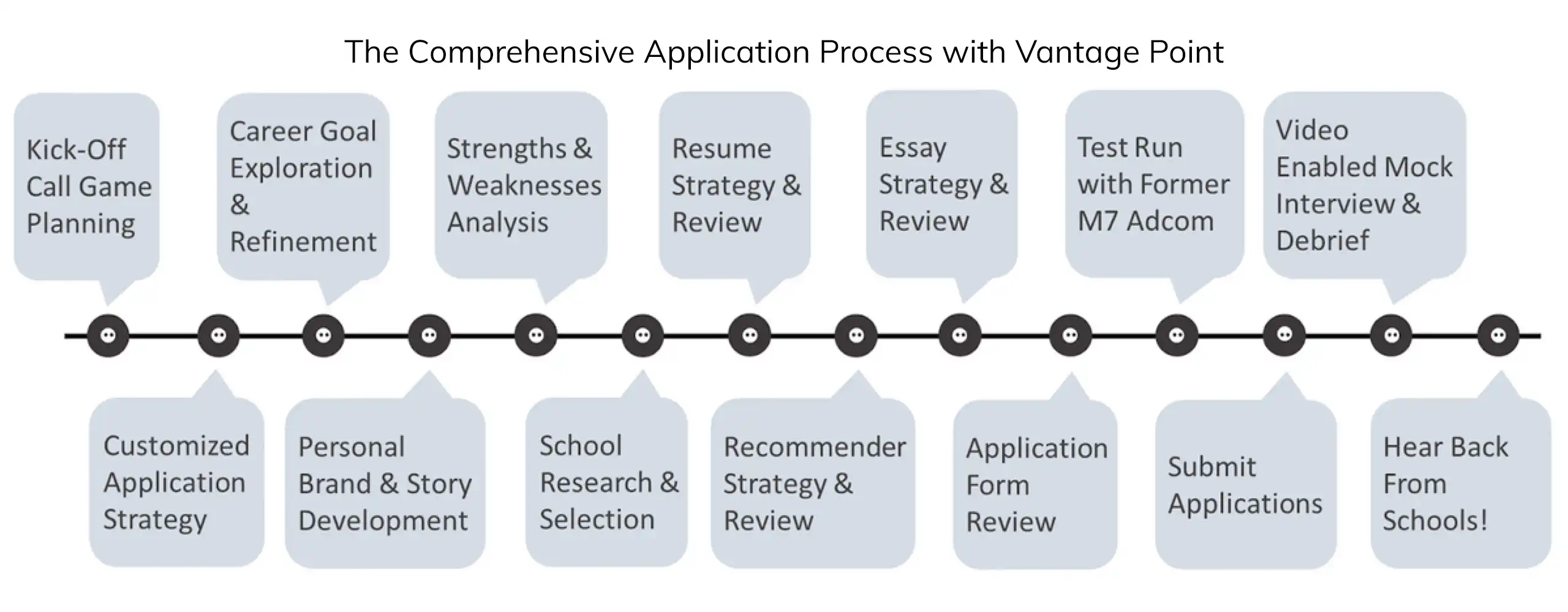How to Network for Your MBA Applications (And Why You Should Start Now) + A Free Download
How to network and why exactly networking is important is something we’re frequently asked by our MBA admissions consulting clients. In an already subjective and sometimes vague process, “networking” can seem particularly abstract or worse, can simply be another “thing” on your long MBA application to-do list.
While there’s no hard deliverable attached to networking, we believe it’s a critical part of the MBA application process and now’s the perfect time to get started – before the essay questions are released and you’re managing a busy work schedule, summer vacations, and your apps. So, we’ve broken it all down for you here in order to eliminate some of the mystery and ambiguity that surrounds networking.
What Is Networking?
Let’s start there. It’s easy to be confused about what “networking” even means. Some folks think it’s very transactional or artificial (i.e., schmoozing), where you reach out to someone to “get something” like a favor, information, or introduction to another person. While that may be true for some people, that’s not the approach or attitude that we recommend.
Instead, simply put, networking is building relationships. In the case of your MBA applications, it’s building relationships with a variety of folks who are connected to the application process in some way. It’s a two-way street, where you get to know people and they get to know you. Usually, the relationship is initiated because you have something in common – a friend, an interest, a hobby, an employer, etc. – but the relationship is nurtured because you invest in it and because both parties enjoy it and benefit from it.
Oh so “networking” is just a fancy way of saying “meeting new people”, right? Well, yes and no. Yes, because that’s often true but no, because you want to be strategic in your approach. By that I mean that you want to invest your efforts in building relationships with folks who can help guide, mentor, and inform your MBA application process. For instance, a former classmate from undergrad who’s a first-year student at HBS. By connecting with her, you’re sure to gain some valuable insights and advice about the school, its culture, essay tips, etc. And who knows, maybe she’s recruiting at your company for a post-MBA role, and you can share your experience with her in return.
Here’s an MBA application networking worksheet to guide you.
Why Is Networking Important?
Still skeptical as to why networking for your MBA applications is so important? Here are a few things to consider. If your competition (i.e., other applicants) is networking and leveraging all the resources at their disposal to help inform and strengthen their applications and you’re not, you risk losing out. For an even better reason that doesn’t involve “because everyone else is doing it”, networking can help you put together a more cohesive and compelling application, which in turn increases your chances of admission to your dream MBA program. Let’s dig into how that can be.
First and foremost, networking is an opportunity to discover new things about a school that can help solidify your fit and answer to “why X school”. Trust us, a thoughtful and well-researched answer to this question can be the difference that gets you admitted. Most of the time, that kind of information can’t be found on a website.
Networking is also a tremendous opportunity to get valuable advice from folks who have been in your shoes. Learn about the unexpected benefits of an MBA from a recent graduate, learn from past MBA students’ mistakes, and get admissions “tips” from folks who have insight into the process. The advice you get along the way can help make the process more efficient, straight-forward, or at least slightly less stressful for you.
Lastly, the MBA application process can seem like a long, lonely journey and it’s nice to feel supported along the way. My clients are usually blown away (I know I definitely was) by how supportive and helpful current students, alums, colleagues with MBAs, etc. are once they find out you’re pursuing an MBA. MBA’s love to pay-it-forward, so let them! Just be sure to be appreciative and stay in touch with them once you have news about decisions so they can remain invested in your journey.
Networking – What Not to Do
It should go without saying that all social etiquette rules apply in MBA application networking but just as a quick refresher, here are a few key “DON’Ts”.
DON’T wait until the last minute: networking is not an on-off switch and should be approached like a marathon, not a sprint. Building relationships, scheduling coffee chats, etc. takes time. So, start early – like now! Give yourself space to follow-up with your new contacts and keep in touch with them throughout the process. Waiting until two days before the deadline to reach out to a current student with a list of questions whose answers you will plug into your “why school X” essay will not do you any favors.
DON’T ask basic or shallow questions: when you’ve finally nailed down that coffee with an alum from your dream school, don’t waste their time asking questions with answers you could easily find on your own. Instead, come with thoughtful questions whose answers will truly further your understanding of how the school fits with your goals and objectives. (Here’s a more comprehensive school selection tool if you’re just getting started.) You want the other person to be impressed with your level of research because who knows, they may end up being an advocate for your candidacy if they also feel like you’re the right fit for their school!
DON’T be disrespectful or ungrateful for the other person’s time: MBA students, alums, representatives from admissions, etc. are all very busy and while they’re happy to help, it takes effort on their part. So be sure to express your gratitude for their time and input. If they tell you they can only spare 20 minutes, remain vigilant of the time and wrap up accordingly. Those manners will go a long way in leaving a good impression.
How To Get Started Networking
With all that said, there’s really isn’t a wrong way to start building your network. In thinking about what the ideal network looks like, it’s comprised of current students and/or alums from your target schools, colleagues/former classmates/mentors, etc. with MBAs, and people in your target post-MBA industry/function. (Note that these three categories are not mutually exclusive – most likely one person will fall into more than one bucket.)
An easy place to start is with your existing network – people from work, undergrad, personal circles, etc. who have MBA’s or are somehow connected to an MBA program. Make a list of these individuals and start reaching out to them for a Zoom chat, after-work cocktail, etc. Be present during these conversations and take mental note of what you discussed. If you chatted about a particular current event or recent trend in your industry, for example, send that person an article on the relevant topic a couple of weeks later to show that you give as well as receive. After each meeting, be sure to ask that person to connect you with someone else from his/her network who could be helpful in your application process. Then repeat.
Lastly, you can take advantage of third-party platforms and events to further build out your network. LinkedIn, MBA forums (reddit, GMAT Club, Beat the GMAT, etc.), and formal networking events (Poets & Quants is hosting a couple this year, for example) are all great places to engage if you feel like your network is a bit sparse.
Networking Directly with Your Target Schools is Important Too
Even if the some of the folks above are current students or graduates from your target schools, you should also plan to engage with the schools directly. A great way to do this is through a campus visit, ideally coordinated through the school so you have a chance to sit in on a class and meet current students in addition to sitting through a presentation from admissions. Many schools are once again beginning to offer these sessions in person, so check with each of your target programs.
If a school visit isn’t possible, plan to attend at least one virtual information session or webinar. These are great opportunities to hear what the schools believe are their selling points while giving you a chance to ask questions. Current students as well as representatives from admissions typically host these events so it’s a great time to initiate a dialogue with a few of them. Those conversations could even turn into a follow-up meeting or call, depending on how well you connect. Not only will engaging with the schools in as many ways as possible help you determine which programs are the right fit for you and why, but it indicates to the admission committee that you’re serious about their program and have made the effort to get to know it. Some schools make this a critical part of their admissions decisions so it’s worth putting in the time (i.e., more is more!).
It’s ultimately up to you to find your own personal style of networking that makes you feel comfortable and authentic, but rest assured that doing this right will only contribute to stronger applications.
Finally, here is the link to our free worksheet download. This tool is a great way to organize your networking plans and ensure you have all your bases covered.
Best of luck!





Pingback: 2024-2025 Columbia MBA Essay Tips
July 11, 2024 10:22 pm